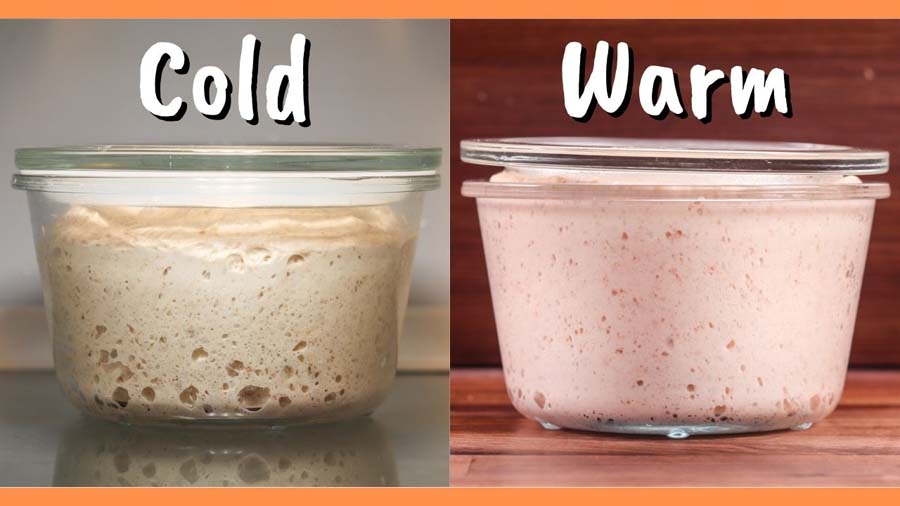Slow fermentation is the best method for achieving better flavour in our bread.
Besides taste it also makes the crust crispier and gives the bread a nice chew. And it can make it stay fresher for longer.
My go-to method is cold bulk fermentation and I have made quite a few videos about it. But cold fermentation is not the only way to extend fermentation time. Bread can also be fermented at room temperature for long periods of time. Instead of cooling it down we simply use less yeast.
That got me thinking about which method produces a tastier bread and which is better overall. There are advantages and disadvantages to both and which method we use could depend on practicality.
I have talked about the effects of fermentation in a previous video, so I will not go too much into detail here. We will make two breads using different methods and simply compare the two methods and the resulting breads.
The recipe specs.
Both breads contained the same ingredients. White bread flour, whole wheat bread flour, salt, yeast, and water. The only difference was the amount of yeast used in each recipe.
The cold fermented bread contained 200g (7oz) white bread flour, 20g (0.7oz) whole wheat flour, 4.5g (0.16oz) salt, 2.2g (0.08oz) instant dry yeast and 135g (4.75oz) water. Bulk fermentation temperature was 5C (41F).
The room temperature fermented bread contained 200g (7oz) white bread flour, 20g (0.7oz) whole wheat flour, 4.5g (0.16oz) salt, 0.3g (0.01oz) instant dry yeast, and 135g (4.75oz) water. Bulk fermentation temperature was 20C (68F).
Bulk fermentation took 12 hours for both. Followed by a 30-minute rest after pre-shaping. Final proofing times were different. The cold fermented dough took 1.5 hours while the other one took 2 hours and 15 minutes. Both were baked for 30 minutes at 200C (392F) fan off.
There are two ways that we can slow down fermentation – lower the temperature or lower the amount of yeast.
When it comes to cold fermentation it is extremely simple because we just mix the dough and pop it in the fridge where it will cool down and slow down. The advantage is that the fridge will have a constant and predictable temperature throughout the day/night. Once you find out the amount of yeast needed to ferment the dough in a certain time you never have to worry about calculations anymore. I know that my dough will ferment well in my fridge when I use 1% yeast in any given recipe.
When fermenting at room temperature we must consider the fact that room temperature is not always constant. The kitchen may be much warmer during the day and cooler at night. Another thing to consider is that yeast will grow exponentially at room temperature and the dough will rise faster and faster over time, so the amount of yeast that we can use must be extremely small. I used 0.1% of yeast in the test for room temperature fermentation and that was almost too much.
Another issue for the home baker is the tiny amount of yeast. Most scales are not precise enough to weigh such small amounts reliably. Of course, this would be less of an issue if you were making a larger batch of dough. But then you must consider the fact that a larger dough will ferment even more rapidly than a smaller one.
So, fermenting at room temperature can be more unpredictable and less practical. Doing it in the summer heat may even be impossible.
Thoughts.
To be honest I was expecting there to be quite a difference between the two breads. I thought that the cold fermented one will have a much more intense flavour because cold fermentation promotes bacterial activity. But to my surprise they turned out quite like each other.
The cold fermented one was just slightly more acidic, and it had more of a chewy interior, but not by much. It would be very hard to tell them apart in a blind taste test. Still, to me the cold fermented bread was the winner when it came to taste and texture. Those two things are highly subjective though.
I think the main difference is practicality. Cold bulk fermentation is so much easier, more consistent, and predictable. If you have the space in your fridge, then it’s a no brainer. Cold fermentation is the ultimate bread making method. At least when it comes to commercial yeast.
Plus, if you want to maximise the flavour even more, then you can easily leave the dough in the fridge for an additional day or two without any issues. You can definitely not do that at room temperature!
Watch the video here



